-
Posts
5,881 -
Joined
-
Last visited
-
Days Won
8
Jamie @ Sovereign Hobbies last won the day on July 29 2023
Jamie @ Sovereign Hobbies had the most liked content!
About Jamie @ Sovereign Hobbies

Contact Methods
-
Website URL
http://www.sovereignhobbies.co.uk
Profile Information
-
Gender
Male
-
Location
Aberdeenshire, UK
-
Interests
Constructive feedback on my modelling is welcome
Recent Profile Visitors
Jamie @ Sovereign Hobbies's Achievements

Completely Obsessed Member (6/9)
17.3k
Reputation
-
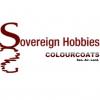
WWII US navy a/c carrier deck markings
Jamie @ Sovereign Hobbies replied to 2Step's topic in Maritime WWII
You'd be surprised. The Japanese decks were bright, untreated high quality timber. Salt water is good for wood - it pickles it and greatly slows any rot. It's fresh water that damages wood. Other ships have had bare wooden decks for centuries. Unless you make a particular effort to make non-slip paint, bare wood has been grip when wet than painted or stained wood. -

WWII US navy a/c carrier deck markings
Jamie @ Sovereign Hobbies replied to 2Step's topic in Maritime WWII
I think you can do as you like as it's your model deck As to painted versus unpainted wood, there is no record that I am aware of that any US Navy carrier entered a combat theatre during WWII with an unpainted wooden deck. There may have been bright wood seen on newly built carriers on a shakedown cruise local to the USA, but I know of none which deployed without a stained flight deck. The mahogany flight decks with chrome yellow markings disappeared roughly the same time the blue-grey over grey aircraft paint schemes were introduced i.e. before the USA joined the war. Again though, it's your model -

WWII US navy a/c carrier deck markings
Jamie @ Sovereign Hobbies replied to 2Step's topic in Maritime WWII
In wartime the answer is fairly simple - most US carriers had little to nothing in the way of deck markings. I'd just paint your Eduard deck with 250-N or FDS21wood planking and 20-B metal, either fresh or weathered as you see fit, and open a beer. -
Whilst clearly heavily damaged, the wreckage of the wing (lying upside down) appears to have slats extended on the outboard portion ahead of the aileron where not burned away, and whilst the flap hinges are burned away the screwjacks appear to be extended enough to place the trailing edge of the flap clearly away from the trailing edge of the aileron, indicating that they were set to at least Flaps 5 degrees. I'd politely suggest we refrain from speculating about a silly Indian crew moving the wrong lever.
-

Jaguar XJ-S (1/43) Heller
Jamie @ Sovereign Hobbies replied to jenko's topic in Ready For Inspection - Vehicles
There is actually only a 50kg difference between the V12 and the XK straight 6, the reason being the XK engine had an iron block and a crankshaft just as long. I've driven 2 E-Types; most of the milage in a Series 2 2+2, and a little (not enough) in a Series 1 FHC. I've always hated automatic gearboxes and it's no different here - the automatic gearbox is easily the worst part of the XJ-S V12. The E-Type feels more direct mostly because of the manual gearbox (in most cases). The E-Type is relatively difficult to get in and out of. The doors are short and the sills very wide, so to get in you have to support your weight whilst threading your legs into the footwell otherwise your knees are at your chest to get your feet in, and getting out is worse. Handling wise they're very similar. The rear suspension is virtually identical of course. The front is likewise very similar. There's no power steering in the E-Type as the tyre tread is a lot narrower, so the steering feels a little better but not hugely so - changing my XJ-S steering wheel from the huge 16" wheel to 14" has alone improved the perception of the steering out on the road. Ride quality is fairly similar. The biggest difference actually is noise and vibration - the XJ-S appears to feel softer but I think it's really because it's more insulated from the outside environment. Whether that's a good or a bad thing maybe depends on the person, or what mood I'm in! I'd love to have a Series 1 FHC E-Type alongside my XJ-S. I still haven't been able to move on with my plan to convert the XJ-S to a manual, but I will. Did I mention I hate automatics? The XJ-S generates a lot of grip though, and has a very low centre of gravity compared to its track, so even in standard form it can corner fairly hard and does so with minimal body roll. -

Jaguar XJ-S (1/43) Heller
Jamie @ Sovereign Hobbies replied to jenko's topic in Ready For Inspection - Vehicles
I am admittedly bias, but the XJ-S is a rare thing nowadays in that it's very distinctive whilst being restrained and elegant. You'll never be confused about whether a shape on the road is an XJ-S or not. I used to prefer the 1994 facelift, but with the benefit of age and hopefully some wisdom that was a mistake. Its original lines look great on it, whilst the 1990s attempt to modernise it merely diluted its identity with 1990s softness. -
You can see in that map that the block causeways are in progress. These would be completed by September 1944 blocking all of the sounds down the east side of Scapa Flow. It's also means you can nowadays disembark a ferry on South Ronaldsay and drive to Kirkwall.
-
There isn't anything better out there. The formulae are partially covered by documentation. They are generally considered to be accurate however my confidence in their methods took a dip after the Royal Navy. There should only be one 5-S standard, but it seems they're unsure and have three. To @Casey I don't think you can put much faith in spectral analysis on these as the chips are visual matches reproduced with different pigments. If you wanted to go to town on this "we" would need to trawl through archival documentation of which I have some but have never looked closely to see if there is enough in there to recreate the paints from original pigments. C-S19-1-5 (341) on 11th July 1941 was the document which I understand introduced 5-S Sea Blue but I don't think I have that here. Introduced around the same time, but in a different document (C-S19-1-7 (341)) was in the 5-TM tinting paste (which I think was similar in concept to the Royal Navy's Pattern 370A and Pattern 371 tinting pastes being composed of ultramarine, a black and pigment extenders), but just like the Royal Navy tinting pastes I don't know the proportions of what was in it. For the RN I did have good data on the final shades of several paints made using it so I was able to reverse engineer them although it was slow and iterative, although I have no mathematical education in the area. Perhaps you could do much better. In short, I don't know the exact original composition of 5-S. I do know the proportions of 5-TM to 5-U White to make 3 paints though: To make 5-H Haze Gray - 2 pints of 5-TM to 5 Gallons of 5-U To make 5-O Ocean Gray - 5 pints of 5-TM to 5 Gallons of 5-U To make 5-S Sea Blue - 10 pints of 5-TM to 5 Gallons of 5-U Presumeably the gallons would be US gallons rather than Imperial. For a bit of orientation on how the US Navy colours came into being, I drew this up with Jeff Herne some years ago. He provided the information. I provided keystrokes and mouse clicks.
-
5-S Sea Blue was rather short lived, and if I were building Saratoga I'd go with 5-N instead (Measure 21) which she spent most of her wartime career wearing. As for Tamiya AS-8, it may serve a purpose to a scale modeller, but I haven't discovered what purpose that might be yet, being a fairly appalling match for everything I've seen it recommended for so far. As for Lifecolor, now that Colourcoats is long sold and clearly I have no vested interest in selling anything I suppose I can say what I really think, which is simply "LOL".
-

S Korean P-3C gone down. Crew lost
Jamie @ Sovereign Hobbies replied to bentwaters81tfw's topic in Real Aviation
What a damned shame. I shall refrain from writing down my speculations but having watched the video I suspect I can (privately) guess at some aspects of the accident. -
I agree with you about flags Mark - much like "crash dioramas" that virtually all novice aircraft modellers go through or indeed sea bases for ships, flags are something which one so rarely sees done well. Done badly, which is the vast majority of the time, they draw attention and detract from the model. Worse, if you do go down the flag route you need structural rigging which will not deflect or twist under the weight of the flag which does not fly naturally like in real life. In my personal opinion, flags are best avoided unless it's something the modeller has seriously practiced and developed a rock solid technique for. Better to lament something missing than to always see something which ruins the model.
-
It's just a very short trip up the hill southwards from Kirkwall over a summit and down again and you're basically at the village of Scapa. As you crest the summit leaving Kirkwall you have a good clear view of most of Scapa Flow including the southern entrance at Hoxa Head, Flotta, Fara and Cava with the high ground of Hoy in the distance. The view of the western end where the German battleships and battlecruisers were scuttled is obscured but the Home Fleet didn't anchor over there for obvious reasons. Richard's photograph there is generally representative of the view. As he rightly says it's facing north. The towers on the hill on the background are a couple of miles west of Kirkwall.
-
I'd usually find that the exact black used didn't have that much effect to be honest, but mixing white, black and most yellows would create something most casual observers would identify as a green. Granted you'll never get a bright green or even a minty green that way, nor can you make a nice torquoise that way by adding blue, but you will end up with an olive shade. The famous US Interior Green ANA611 or "zinc chromate green" was literally yellow zinc chromate tinted with some black. Which black exactly mattered little but the human eye perceives it as green. To make something a layperson would identify as brown, generally you need to mix white, black, yellow and red.
-
Thanks for this. That's a surprisingly large quantity of chrome yellow given the cost of the stuff. I would venture though, and this is purely speculation on my part, that if you're going to see batch variance between manufacturers that's where it'll be e.g. some deciding that the drab colour is close enough with reduced quantities of the expensive yellow which serves only to increase the saturation. It does confirm there's no green in it anywhere though. It's white, yellow and black. The magnesium silicate (talc) and diatomaceous silicate will have been the flattening agent and general pigment extenders to make the liquid paint more structured and easier to coat with.





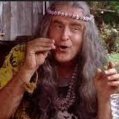
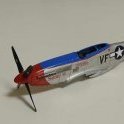


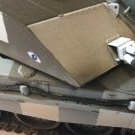
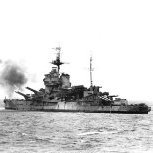



.thumb.jpg.72770d5328cc1f37a46fff4fba91b26e.jpg)




